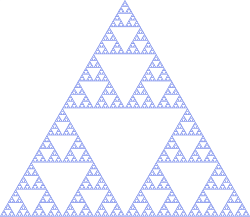The Subtle Art of Not Giving a F Pdf Signature

A visual form of recursion known as the Droste effect. The woman in this image holds an object that contains a smaller image of her holding an identical object, which in plough contains a smaller image of herself holding an identical object, and then forth. 1904 Droste cocoa tin, designed by January Misset
Recursion (adjective: recursive) occurs when a thing is divers in terms of itself or of its type. Recursion is used in a variety of disciplines ranging from linguistics to logic. The almost common awarding of recursion is in mathematics and estimator science, where a function beingness defined is applied inside its ain definition. While this manifestly defines an space number of instances (part values), it is often done in such a way that no infinite loop or space chain of references ("crock recursion") tin occur.
Formal definitions

Ouroboros, an ancient symbol depicting a serpent or dragon eating its own tail.
In mathematics and computer scientific discipline, a class of objects or methods exhibits recursive behavior when it can be defined by two properties:
- A simple base case (or cases) — a terminating scenario that does not use recursion to produce an respond
- A recursive footstep — a set of rules that reduces all successive cases toward the base instance.
For example, the post-obit is a recursive definition of a person's antecedent. 1'due south antecedent is either:
- One's parent (base case), or
- 1's parent's ancestor (recursive step).
The Fibonacci sequence is another classic example of recursion:
- Fib(0) = 0 every bit base instance 1,
- Fib(one) = 1 as base of operations case 2,
- For all integers n > 1, Fib(n) = Fib(due north − ane) + Fib(n − 2).
Many mathematical axioms are based upon recursive rules. For instance, the formal definition of the natural numbers by the Peano axioms tin can be described equally: "Nil is a natural number, and each natural number has a successor, which is also a natural number."[1] Past this base instance and recursive rule, one tin can generate the ready of all natural numbers.
Other recursively defined mathematical objects include factorials, functions (e.g., recurrence relations), sets (eastward.thousand., Cantor ternary set), and fractals.
In that location are various more tongue-in-cheek definitions of recursion; see recursive sense of humour.
Breezy definition

Recently refreshed sourdough, bubbling through fermentation: the recipe calls for some sourdough left over from the last time the same recipe was made.
Recursion is the process a procedure goes through when one of the steps of the procedure involves invoking the procedure itself. A procedure that goes through recursion is said to exist 'recursive'.[two]
To empathize recursion, one must recognize the stardom between a procedure and the running of a process. A process is a gear up of steps based on a set of rules, while the running of a procedure involves actually post-obit the rules and performing the steps.
Recursion is related to, just not the same every bit, a reference within the specification of a process to the execution of some other procedure.
When a procedure is defined as such, this immediately creates the possibility of an countless loop; recursion can but be properly used in a definition if the footstep in question is skipped in certain cases so that the procedure tin complete. Recursion comes in three forms: directly, indirect, and circular. Straight recursion is when a function (A) invokes itself (A references A); indirect recursion occurs when one function (A) invokes (B), role (B) invokes function (C), function (C) invokes (D), etc., until i of the functions in the concatenation invokes an earlier i. Circular recursion occurs when function (A) and function (B) invoke each other. If an space loop occurs in straight, indirect, or circular recursion, information technology is said to be the condition of "crock recursion." There are basically two ways to forbid crock recursion, either limit the number of times a role may reference itself, or place an accented limit on the depth of part calls, east.g. if there is a depth limit of 50, any time a procedure calls another, a counter is increased; when it exits, that counter is decreased. Once the counter reaches the limit (in this instance, fifty) no further procedure calls are allowed; if any endeavour to call a 51st function is made, the operation is terminated. Using a recursion limit prevents only crock recursion; placing a phone call limit, in add-on to halting crock recursion, may have the side effect of preventing the execution of legitimate complex procedures which are deeply nested, but non recursive.
But fifty-fifty if it is properly defined, a recursive procedure is not easy for humans to perform, equally it requires distinguishing the new from the old, partially executed invocation of the procedure; this requires some assistants as to how far diverse simultaneous instances of the procedures have progressed. For this reason, recursive definitions are very rare in everyday situations.
In language
Linguist Noam Chomsky, among many others, has argued that the lack of an upper bound on the number of grammatical sentences in a language, and the lack of an upper spring on grammatical sentence length (beyond practical constraints such every bit the time bachelor to utter one), can be explained equally the result of recursion in natural language.[3] [iv]
This can be understood in terms of a recursive definition of a syntactic category, such as a sentence. A judgement tin have a construction in which what follows the verb is another sentence: Dorothy thinks witches are dangerous, in which the judgement witches are dangerous occurs in the larger one. And then a judgement can exist divers recursively (very roughly) as something with a structure that includes a substantive phrase, a verb, and optionally another sentence. This is really but a special instance of the mathematical definition of recursion.
This provides a way of agreement the creativity of language—the unbounded number of grammatical sentences—because it immediately predicts that sentences can be of arbitrary length: Dorothy thinks that Toto suspects that Tin Man said that.... At that place are many structures autonomously from sentences that can exist defined recursively, and therefore many ways in which a judgement can embed instances of one category inside another.[5] Over the years, languages in general have proved amenable to this kind of analysis.
Recently, withal, the generally accepted idea that recursion is an essential property of human language has been challenged by Daniel Everett on the ground of his claims nigh the Pirahã linguistic communication. Andrew Nevins, David Pesetsky and Cilene Rodrigues are amongst many who have argued against this.[6] Literary self-reference tin in any instance exist argued to be different in kind from mathematical or logical recursion.[7]
Recursion plays a crucial role not only in syntax, but besides in natural language semantics. The word and, for instance, tin can exist construed as a function that tin employ to sentence meanings to create new sentences, and likewise for noun phrase meanings, verb phrase meanings, and others. Information technology can also employ to intransitive verbs, transitive verbs, or ditransitive verbs. In order to provide a single denotation for information technology that is suitably flexible, and is typically defined then that it can accept any of these unlike types of meanings as arguments. This can be done by defining information technology for a uncomplicated case in which information technology combines sentences, and so defining the other cases recursively in terms of the simple one.[8]
A recursive grammar is a formal grammar that contains recursive production rules.[nine]
Recursive humour

Recursion is sometimes used humorously in information science, programming, philosophy, or mathematics textbooks, mostly past giving a circular definition or self-reference, in which the putative recursive pace does not become closer to a base example, but instead leads to an infinite regress. Information technology is non unusual for such books to include a joke entry in their glossary forth the lines of:
- Recursion, see Recursion.[10]
A variation is found on page 269 in the index of some editions of Brian Kernighan and Dennis Ritchie's book The C Programming Language; the index entry recursively references itself ("recursion 86, 139, 141, 182, 202, 269"). Early versions of this joke can be found in Let's talk Lisp past Laurent Siklóssy (published by Prentice Hall PTR on December 1, 1975, with a copyright appointment of 1976) and in Software Tools by Kernighan and Plauger (published by Addison-Wesley Professional on January eleven, 1976). The joke too appears in The UNIX Programming Environment by Kernighan and Freeway. It did not announced in the first edition of The C Programming Language. The joke is part of the Functional programming sociology and was already widespread in the functional programming customs before the publication of the aforementioned books.
Another joke is that "To sympathise recursion, y'all must understand recursion."[x] In the English-language version of the Google web search engine, when a search for "recursion" is made, the site suggests "Did you mean: recursion."[11] An alternative form is the following, from Andrew Plotkin: "If you lot already know what recursion is, just remember the respond. Otherwise, find someone who is continuing closer to Douglas Hofstadter than you are; then ask him or her what recursion is."
Recursive acronyms are other examples of recursive humor. PHP, for example, stands for "PHP Hypertext Preprocessor", Vino stands for "WINE Is Not an Emulator" GNU stands for "GNU's not Unix", and SPARQL denotes the "SPARQL Protocol and RDF Query Language".
In mathematics

Recursively defined sets
Example: the natural numbers
The canonical case of a recursively defined ready is given past the natural numbers:
- 0 is in
- if n is in , then n + 1 is in
- The set of natural numbers is the smallest set satisfying the previous ii properties.
In mathematical logic, the Peano axioms (or Peano postulates or Dedekind–Peano axioms), are axioms for the natural numbers presented in the 19th century by the German mathematician Richard Dedekind and past the Italian mathematician Giuseppe Peano. The Peano Axioms define the natural numbers referring to a recursive successor function and addition and multiplication every bit recursive functions.
Case: Proof procedure
Some other interesting case is the set of all "provable" propositions in an axiomatic system that are divers in terms of a proof procedure which is inductively (or recursively) divers as follows:
- If a proposition is an axiom, it is a provable proposition.
- If a proposition can exist derived from truthful reachable propositions by means of inference rules, it is a provable proffer.
- The fix of provable propositions is the smallest set up of propositions satisfying these conditions.
Finite subdivision rules
Finite subdivision rules are a geometric form of recursion, which can be used to create fractal-similar images. A subdivision rule starts with a collection of polygons labelled by finitely many labels, and then each polygon is subdivided into smaller labelled polygons in a way that depends only on the labels of the original polygon. This process can be iterated. The standard `middle thirds' technique for creating the Cantor set is a subdivision rule, equally is barycentric subdivision.
Functional recursion
A office may be recursively defined in terms of itself. A familiar example is the Fibonacci number sequence: F(n) = F(n − 1) + F(due north − 2). For such a definition to be useful, it must be reducible to non-recursively defined values: in this case F(0) = 0 and F(1) = 1.
A famous recursive function is the Ackermann role, which, dissimilar the Fibonacci sequence, cannot be expressed without recursion.[ citation needed ]
Proofs involving recursive definitions
Applying the standard technique of proof past cases to recursively defined sets or functions, equally in the preceding sections, yields structural induction — a powerful generalization of mathematical consecration widely used to derive proofs in mathematical logic and computer scientific discipline.
Recursive optimization
Dynamic programming is an approach to optimization that restates a multiperiod or multistep optimization problem in recursive form. The key result in dynamic programming is the Bellman equation, which writes the value of the optimization problem at an earlier time (or earlier stride) in terms of its value at a later fourth dimension (or afterward stride).
The recursion theorem
In prepare theory, this is a theorem guaranteeing that recursively divers functions exist. Given a prepare X, an element a of X and a function f: 10 → Ten , the theorem states that in that location is a unique part (where denotes the set of natural numbers including nada) such that
for whatever natural number n.
Proof of uniqueness
Take two functions and such that:
where a is an element of X.
It tin exist proved by mathematical consecration that F(n) = G(n) for all natural numbers north:
- Base Case: F(0) = a = G(0) so the equality holds for n = 0.
- Inductive Step: Suppose F(one thousand) = G(k) for some . Then F(k + 1) = f(F(m)) = f(G(thousand)) = One thousand(k + 1).
- Hence F(thou) = G(chiliad) implies F(m + i) = G(m + 1).
By induction, F(n) = G(due north) for all .
In computer science
A common method of simplification is to divide a problem into subproblems of the aforementioned blazon. As a computer programming technique, this is called carve up and conquer and is key to the design of many important algorithms. Split and conquer serves every bit a top-downwardly approach to trouble solving, where problems are solved past solving smaller and smaller instances. A reverse approach is dynamic programming. This approach serves as a bottom-up arroyo, where problems are solved by solving larger and larger instances, until the desired size is reached.
A classic example of recursion is the definition of the factorial function, given here in C code:
unsigned int factorial ( unsigned int north ) { if ( northward == 0 ) { render ane ; } else { return n * factorial ( n - 1 ); } } The function calls itself recursively on a smaller version of the input (n - 1) and multiplies the result of the recursive call past n, until reaching the base of operations example, analogously to the mathematical definition of factorial.
Recursion in figurer programming is exemplified when a function is divers in terms of simpler, often smaller versions of itself. The solution to the problem is then devised by combining the solutions obtained from the simpler versions of the trouble. One instance application of recursion is in parsers for programming languages. The corking advantage of recursion is that an infinite prepare of possible sentences, designs or other data tin be defined, parsed or produced by a finite figurer program.
Recurrence relations are equations which ascertain one or more sequences recursively. Some specific kinds of recurrence relation can exist "solved" to obtain a not-recursive definition (e.g., a airtight-form expression).
Employ of recursion in an algorithm has both advantages and disadvantages. The primary advantage is normally the simplicity of instructions. The main disadvantage is that the memory usage of recursive algorithms may grow very quickly, rendering them impractical for larger instances.
In biology
Shapes that seem to have been created by recursive processes sometimes appear in plants and animals, such as in branching structures in which i large part branches out into two or more similar smaller parts. I example is Romanesco broccoli.[12]
In art


Forepart face up of Giotto'southward Stefaneschi Triptych, 1320, recursively contains an epitome of itself (held upwards by the kneeling effigy in the central panel).
The Russian Doll or Matryoshka doll is a physical creative example of the recursive concept.[xiii]
Recursion has been used in paintings since Giotto'south Stefaneschi Triptych, made in 1320. Its central panel contains the kneeling effigy of Cardinal Stefaneschi, holding upwards the triptych itself as an offer.[14] [xv] This do is more than generally known equally the Droste effect, an instance of the Mise en abyme technique.
M. C. Escher's Print Gallery (1956) is a impress which depicts a distorted urban center containing a gallery which recursively contains the flick, then advertisement infinitum.[sixteen]
See also
- Corecursion
- Grade-of-values recursion
- Digital infinity
- A Dream Within a Dream (poem)
- Droste issue
- False awakening
- Fixed betoken combinator
- Infinite compositions of analytic functions
- Infinite loop
- Space backslide
- Infinitism
- Infinity mirror
- Iterated function
- Mathematical induction
- Mise en abyme
- Reentrant (subroutine)
- Self-reference
- Spiegel im Spiegel
- Strange loop
- Tail recursion
- Tupper's self-referential formula
- Turtles all the way down
References
- ^ "Peano axioms | mathematics". Encyclopedia Britannica . Retrieved 2019-10-24 .
- ^ "Definition of RECURSIVE". www.merriam-webster.com . Retrieved 2019-10-24 .
- ^ Pinker, Steven (1994). The Language Instinct. William Morrow.
- ^ Pinker, Steven; Jackendoff, Ray (2005). "The kinesthesia of language: What's and then special nigh it?". Noesis. 95 (two): 201–236. CiteSeerX10.1.one.116.7784. doi:10.1016/j.cognition.2004.08.004. PMID 15694646. S2CID 1599505.
- ^ Nordquist, Richard. "What Is Recursion in English Grammer?". ThoughtCo . Retrieved 2019-10-24 .
- ^ Nevins, Andrew; Pesetsky, David; Rodrigues, Cilene (2009). "Evidence and argumentation: A reply to Everett (2009)" (PDF). Language. 85 (three): 671–681. doi:10.1353/lan.0.0140. S2CID 16915455. Archived from the original (PDF) on 2012-01-06.
- ^ Drucker, Thomas (four January 2008). Perspectives on the History of Mathematical Logic. Springer Science & Business organisation Media. p. 110. ISBN978-0-8176-4768-1.
- ^ Barbara Partee and Mats Rooth. 1983. In Rainer Bäuerle et al., Pregnant, Apply, and Interpretation of Language. Reprinted in Paul Portner and Barbara Partee, eds. 2002. Formal Semantics: The Essential Readings. Blackwell.
- ^ Nederhof, Mark-January; Satta, Giorgio (2002), "Parsing Non-recursive Context-free Grammars", Proceedings of the 40th Annual Meeting on Association for Computational Linguistics (ACL '02), Stroudsburg, PA, USA: Clan for Computational Linguistics, pp. 112–119, doi:10.3115/1073083.1073104 .
- ^ a b Hunter, David (2011). Essentials of Discrete Mathematics. Jones and Bartlett. p. 494. ISBN9781449604424.
- ^ "recursion - Google Search". www.google.com . Retrieved 2019-x-24 .
- ^ "Picture show of the Day: Fractal Cauliflower". 28 Dec 2012. Retrieved xix April 2020.
- ^ Tang, Daisy. "Recursion". Retrieved 24 September 2015.
More than examples of recursion: Russian Matryoshka dolls. Each doll is made of solid wood or is hollow and contains another Matryoshka doll inside it.
- ^ "Giotto di Bondone and administration: Stefaneschi triptych". The Vatican. Retrieved 16 September 2015.
- ^ Svozil, Karl (2018). Physical (A)Causality: Determinism, Randomness and Uncaused Events. Springer. p. 12.
- ^ Cooper, Jonathan (5 September 2007). "Fine art and Mathematics". Retrieved 5 July 2020.
Bibliography
- Dijkstra, Edsger Due west. (1960). "Recursive Programming". Numerische Mathematik. 2 (1): 312–318. doi:10.1007/BF01386232. S2CID 127891023.
- Johnsonbaugh, Richard (2004). Discrete Mathematics. Prentice Hall. ISBN978-0-xiii-117686-7.
- Hofstadter, Douglas (1999). Gödel, Escher, Bach: an Eternal Golden Braid. Basic Books. ISBN978-0-465-02656-2.
- Shoenfield, Joseph R. (2000). Recursion Theory . A K Peters Ltd. ISBN978-i-56881-149-9.
- Causey, Robert Fifty. (2001). Logic, Sets, and Recursion . Jones & Bartlett. ISBN978-0-7637-1695-0.
- Cori, Rene; Lascar, Daniel; Pelletier, Donald H. (2001). Recursion Theory, Gödel's Theorems, Gear up Theory, Model Theory. Oxford University Press. ISBN978-0-19-850050-6.
- Barwise, Jon; Moss, Lawrence Southward. (1996). Brutal Circles. Stanford Univ Center for the Study of Language and Data. ISBN978-0-nineteen-850050-half-dozen. - offers a treatment of corecursion.
- Rosen, Kenneth H. (2002). Discrete Mathematics and Its Applications. McGraw-Hill College. ISBN978-0-07-293033-7.
- Cormen, Thomas H.; Leiserson, Charles Eastward.; Rivest, Ronald L.; Stein, Clifford (2001). Introduction to Algorithms. Mit Pr. ISBN978-0-262-03293-3.
- Kernighan, B.; Ritchie, D. (1988). The C programming Linguistic communication. Prentice Hall. ISBN978-0-13-110362-7.
- Stokey, Nancy; Robert Lucas; Edward Prescott (1989). Recursive Methods in Economical Dynamics. Harvard University Press. ISBN978-0-674-75096-8.
- Hungerford (1980). Algebra. Springer. ISBN978-0-387-90518-i. , first chapter on set up theory.
External links
- Recursion - tutorial past Alan Gauld
- Zilch Files All The Manner Downward
- Nevins, Andrew and David Pesetsky and Cilene Rodrigues. Evidence and Argumentation: A Reply to Everett (2009). Linguistic communication 85.three: 671--681 (2009)
Source: https://en.wikipedia.org/wiki/Recursion









0 Response to "The Subtle Art of Not Giving a F Pdf Signature"
Post a Comment